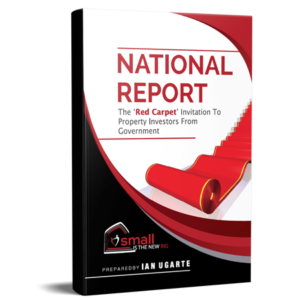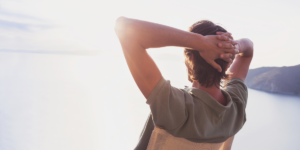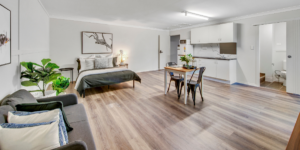I’m all for living large – I’ve got 4 daughters! But seriously, for me it’s all about making the most of smaller spaces to get a better outcome for life.
I advocate strongly (everywhere I can) for micro-apartment conversions as rental investments because they benefit owners and tenants alike. Property owners can double their rental cashflow (or in some cases, triple it). And tenants get financial and other benefits over the traditional kinds of rentals.
But it does rely on designing, renovating and setting up the property strategically.
For any of you subscribing to a micro-apartment approach, I recommend, strongly, that you take these 6 micro principles seriously. That’s how you’ll see returns on your rental investment and help with Australia’s property affordability crisis.

1. Get the community part right
Micro-apartment houses might look like all the others in the street but inside they’re quite different. Each apartment is generally self-contained with its own kitchenette, sitting area, bedroom and bathroom. But tenants still share the heart of the home, i.e., the kitchen. This is where they can do their cooking – and mingling if they’re so inclined.
Don’t forget to plan for those communal spaces because that’s how the genuine community connection is created and how isolated is avoided.
Another important consideration when building your community is engaging a rental agent with experience in co-living properties. The right agent will select candidates most likely to create social cohesion within the home.

2. Get the layout right
When you’re re-thinking the layout of an existing home to turn into micro-apartments, your aim should be to create a functional floor plan that keeps your costs to a minimum without scrimping on quality or on areas that are useful.
My first tip is a well-worn one but worth repeating: make sure you look at the load-bearing walls in the property. Don’t take away the structure.
Secondly, as a builder and plumber by trade, I always say, with a rental investment aim to keep the plumbing where it is, if you can. It’s a real bonus for cost saving. In the renovations we project manage as part of our INVIDA service, we don’t dig into the concrete when we add bathrooms. We do everything above the floor level.
The next step is to plan how you will include those communal areas mentioned above, to achieve that mix of private and shared spaces.
And finally, think carefully about your outdoor spaces. See whether you have room for veggie gardens, sitting areas or barbecue zones, which are all great for communal use.

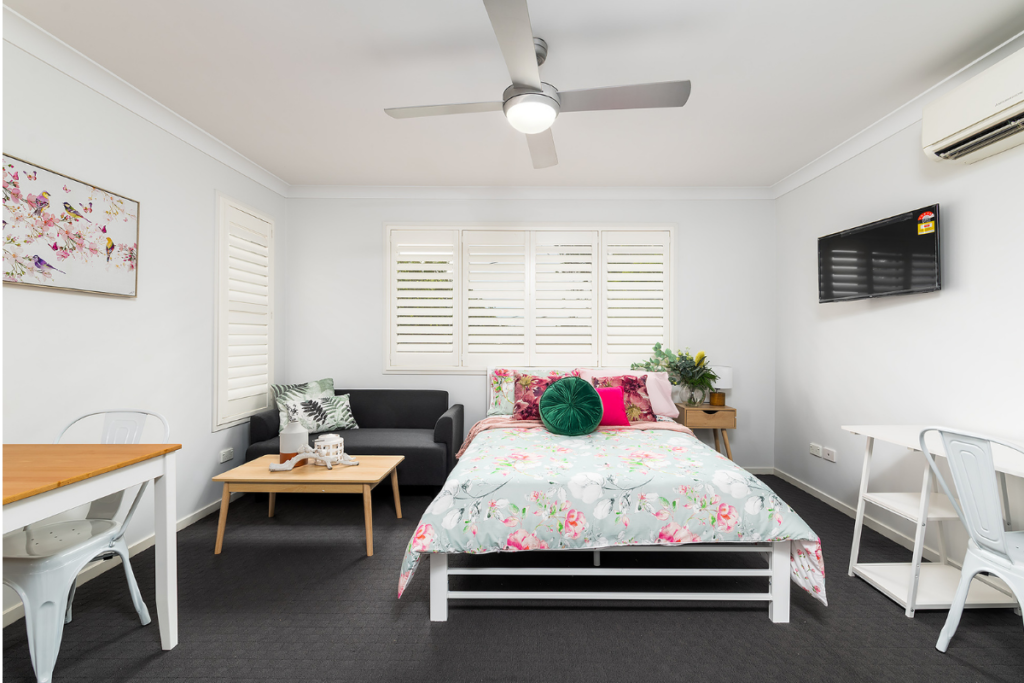
3. Renovate to feel bigger and more appealing
Once you’ve decided on a layout for your rental investment, your next challenge is to make the space feel larger and visually appealing. There are a few tricks here.
Starting with light, and lots of it. Light makes rooms feel more spacious and for that matter, cheerful.
Then you need to paint, tile and/or wallpaper rooms so they’re either neutral in tone or at least, all one colour, to avoid over busy-ness that can shrink rooms visually. A fresh canvas lets you highlight the room’s ‘wow’ pieces and achieve a feeling of flow and cohesion.
Also watch where you place your main pieces of furniture, and think about how residents will circulate around the room. Try a few different options – it’s amazing how the right configuration can open up the feel of a room.
Opt for smaller furniture too – dining tables, sofas etc. Just not the beds, keep them generous. Offer a queen bed at least.
Put in cabinetry that runs from floor to ceiling, not just because it gives your tenants extra storage space, but because it can fool the eye into believing the ceilings are higher.
And where possible, allow access to a courtyard, verandah or outdoor area, to add to the flow and feeling of spaciousness.
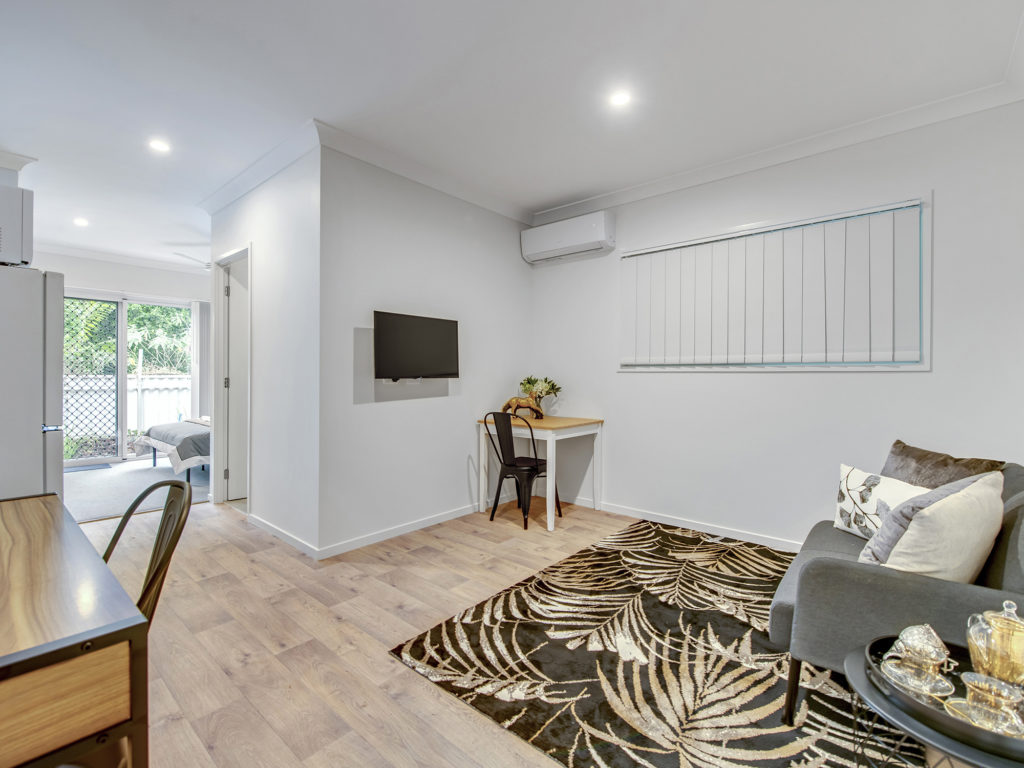
4. Use Multi-purpose adaptable furniture
If you want to achieve a harmonious and uncluttered feel in a small space, it pays to be flexible in your design, and clever in your approach
That starts with taking advantage of some of the genius adaptable furniture available today. (Yes, we’ve come a long way since the fold-up Murphy beds of the 1970s.)
You might have a queen bed with fully-sprung mattress that you flip up or turn around during the day, and voila – it becomes a desk and/or bookshelves – even a sofa, with lots of space around it. That’s how you give your rooms two functions and increase space. Just search for murphy beds on Pinterest and you’ll see a heap of options.
You can also use open bookshelves with drawers as room dividers. Instead of cutting the space in half, it allows your eye to travel through, as well as providing great storage and a funky aesthetic.
Ottomans are smarter these days – many can now serve as coffee tables. We have one in our home that can be made up into a double bed.
That said, don’t ever sacrifice beauty for functionality. You want potential tenants to walk into your micro-apartment and have it feel like home. You want them to fall in love with it.
5. Make the property adaptable
My own family home on the Sunshine Coast in Queensland, where I “live large” with my wife and four daughters, has been renovated with a multi-purpose strategy in mind.
Basically, we’ve designed it so that over the next 100 years or so, it could be lived in by a multi-generational family, by co-living tenants, a couple renting out part of the house or an up-lifer (downsizer), or by the disability sector as an Airbnb – even as a wedding venue!
While you might not want to go that far, my advice is to make sure your rental investment is adaptable. In the future, your circumstances might change, and rather than renting it out for co-living in micro-apartments, it might house a multi-generational family. Yours or your tenants’.
This thinking also fits with what I call circle of life – upsizing as your needs grow, and then downsizing as they diminish.
SCROLL DOWN to find out how you can enrol in my mini-course Co-living 101 for FREE!

6. Tick all the approvals with councils
Once you’ve perfected your layout, furniture and aesthetics, doing internal modifications requires you to go through the relevant approval process for your council area.
Fortunately these days you don’t have to deal with councils direct, you can go to a private certifier or building surveyor, depending on the state you’re in. These professionals are licensed by the council to act as a principal certifying authority (PCA) on your behalf. (See your own state government website for more information, for example, NSW government here and Queensland government here.)
PCAs are responsible for inspecting and approving the building work to ensure it’s been carried out in accordance with approved plans and compliant with state legislation; and that you have all the correct paperwork lodged with council.
They will also check you’ve done the requisite safety upgrades, i.e., that you’ll be protecting the residents who live in your apartments. If you don’t get that checked off, you won’t get insurance.
On that note, if you’re considering a tiny house option for your “small-space-living-large” rental investment, bear in mind there are regulatory barriers to actually living in them. Similarly, granny flats in your backyard, as lucrative as they might seem, aren’t always legally rentable.
And a tiny house or granny flat on its own, while great in theory, doesn’t build a community.
So that’s what I mean by making the most of smaller spaces to get better outcomes. That’s what I mean by living large in a rental investment.
Head to Ticker HOME and watch episode 11 with Jackson Williams and I talking about living large in small spaces.
Join my free co-living 101 course that will kickstart your small property investing journey.

